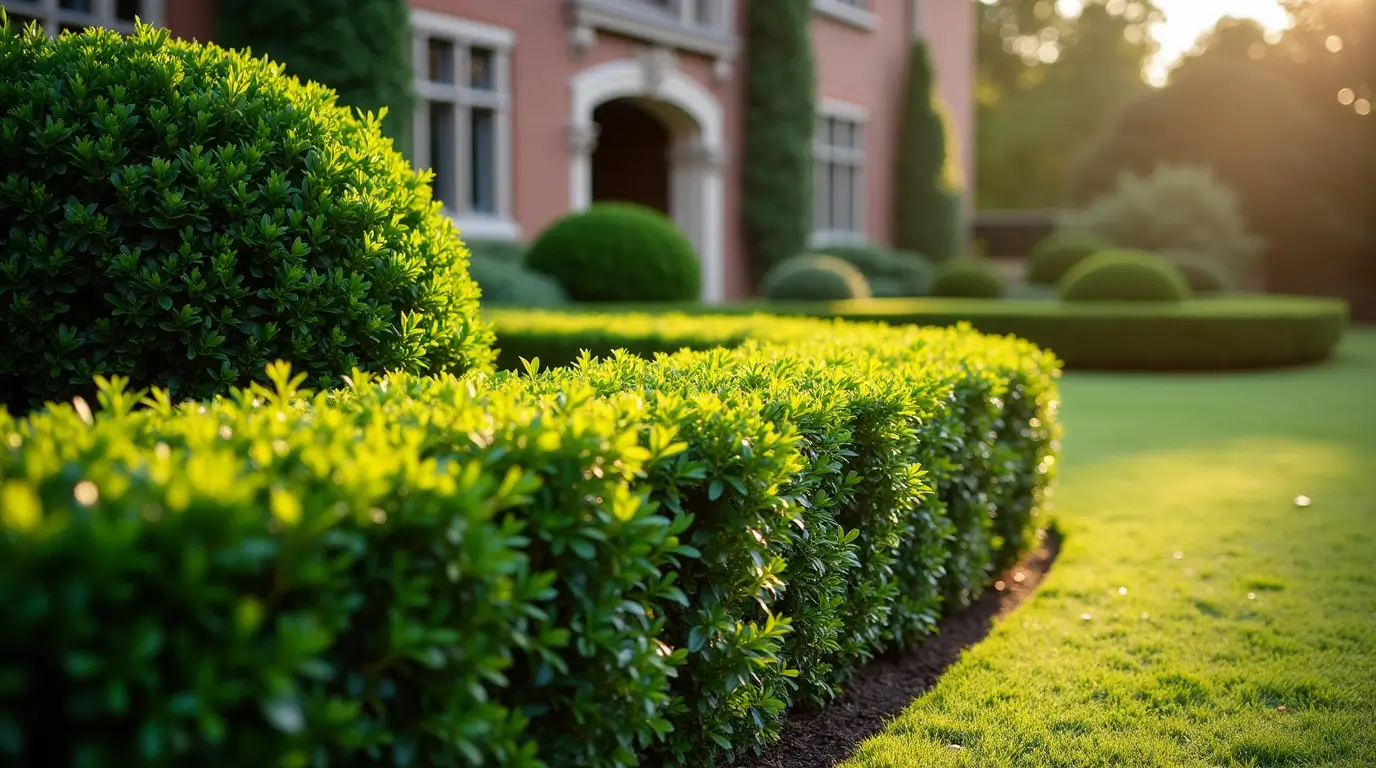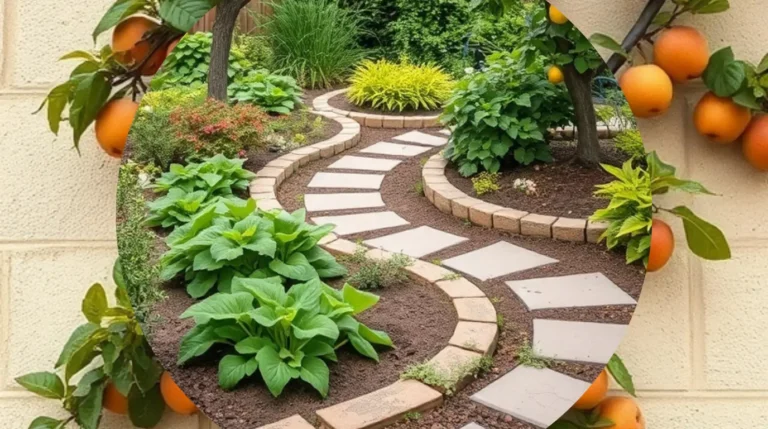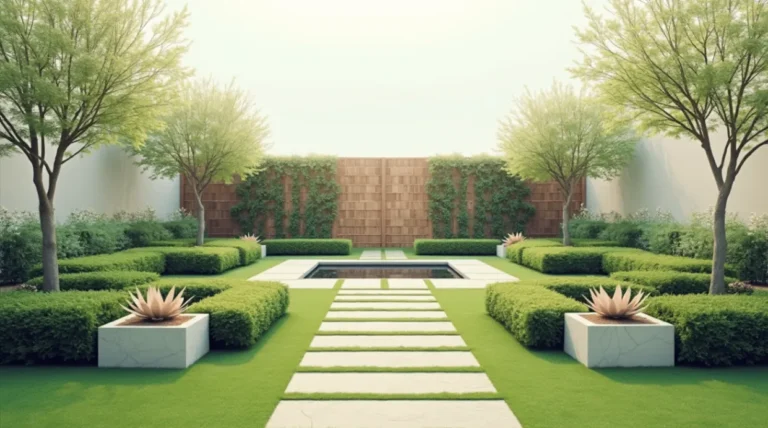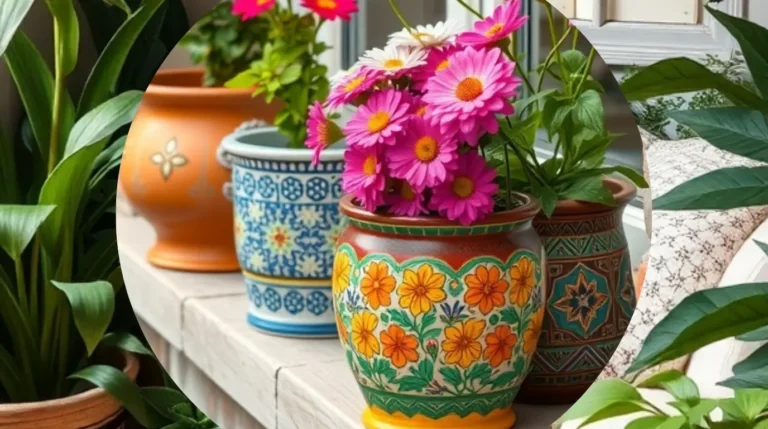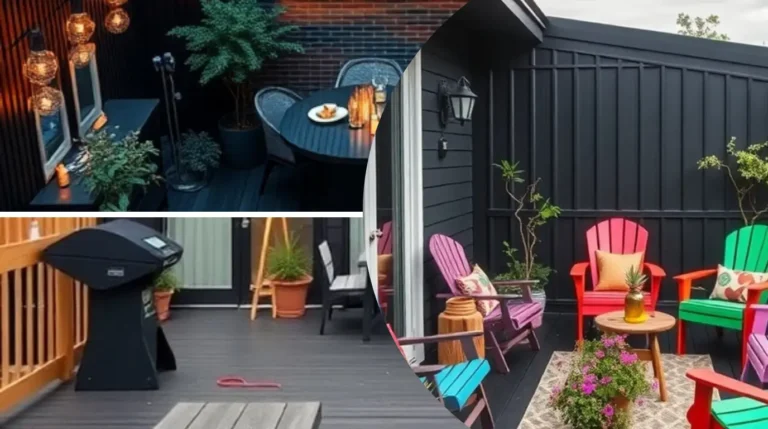Boxwood Landscaping Ideas: How to Create Classic Borders
Boxwood landscaping ideas are a timeless choice for defining spaces and adding elegance to outdoor areas. These classic shrubs have been a garden staple for centuries, offering structure and sophistication. This guide will show you how to design, plant, and maintain boxwood borders.
These borders can enhance curb appeal and create lasting beauty. Whether you’re planning a formal garden or a modern landscape, these strategies will help. They ensure your space reflects both tradition and practicality.

Key Takeaways
- Boxwoods create classic borders that blend form and function in any garden design.
- Proper planting techniques maximize growth and durability for long-term beauty.
- Maintenance practices like pruning and watering sustain healthy shrubs year-round.
- Combining boxwoods with flowers or hardscaping adds visual interest to outdoor spaces.
- Seasonal care ensures borders stay vibrant and maintain their architectural shape.
Introduction to Boxwood Landscaping
Boxwood landscaping brings structured beauty to outdoor spaces. It uses boxwood shrubs for borders, hedges, and patterns. Their evergreen leaves make them a key part of gardens all year.

What is Boxwood Landscaping?
Boxwood landscaping focuses on shaping shrubs into garden features. They are used to outline paths, frame areas, or separate spaces. Their slow growth lets gardeners create detailed shapes, like geometric borders or topiaries.
They are loved in both old estates and modern homes. Boxwoods add sophistication to any landscape.
Benefits of Classic Borders
- Privacy and Boundaries: Tightly trimmed rows block views and create clear garden zones.
- Year-Round Interest: Evergreen leaves ensure visual consistency even in winter.
- Low Water Needs
- : Established plants thrive with minimal irrigation once roots are settled.
- Design Flexibility: They pair with flowers, statues, or pathways to blend tradition with contemporary elements.
Boxwood borders fit any garden style, from formal to cottage. They need little space but offer lasting beauty in every season.
Choosing the Right Boxwood Shrubs
When picking boxwood shrubs for your garden, match their traits to your space’s needs. The climate zone is crucial—like ‘Green Mountain’ for zones 5-8, and ‘Winter Gem’ for warmer areas. Think about the size: ‘Compacta’ stays under 3 feet, which is great for small spots. ‘Arabian’ grows up to 10 feet, perfect for tall hedges.

- Climate Match: Check USDA zone compatibility for year-round survival.
- Space Planning: Measure planting areas to avoid overcrowding.
- Light Needs: Most boxwoods prefer partial shade, but some tolerate full sun.
- Disease Resistance: Opt for cultivars like ‘Green Velvet’ known for blight resistance.
Local nurseries offer advice tailored to your area. Test your soil’s pH—boxwoods do best in slightly acidic to neutral soil. Choose plants with strong roots and no damage. Picking the right boxwood shrubs means less upkeep and better growth. Begin with these steps to find the perfect fit for your garden.
Planning Your Boxwood Garden Design
Starting a boxwood garden design needs careful planning. A good layout and matching colors are key for a lasting outdoor area. Whether it’s a formal parterre or a casual garden path, planning is the base.

Focus on the garden’s layout and color balance. Let’s dive into how to tackle these areas well.
Identifying the Ideal Garden Layout
First, measure your garden and check the sunlight. Rectangular beds suit structured boxwood garden design. Curved lines bring a natural feel. Plan paths and highlights to shape the garden’s flow.
Think about the shrubs’ full size to prevent them from getting too crowded.
Balancing Colors and Textures
Match boxwoods with plants like lavender or deep green ferns for contrast. Add textured elements like gravel or stone paths to enhance the shrubs’ smooth leaves. Mixing rounded and upright boxwoods adds interest without cluttering the area.
- Incorporate evergreens for year-round structure
- Use low-growing flowers to frame boxwood borders
- Experiment with staggered heights for depth
These tips help create a design that’s both traditional and modern. It’s a space that grows beautifully with the seasons.
Boxwood Planting Guide Essentials
Starting with the right soil is key for boxwoods to grow well. First, test your soil’s pH. It should be between 6.0 and 7.0. Then, add compost or organic matter to improve drainage and nutrients.
- Planting depth: Dig holes that are twice as wide as the root ball but not as deep. Place the root ball 1–2 inches above the ground.
- Water the soil well before planting. This helps settle the soil around the roots. Don’t pack the soil too tight to avoid choking the roots.
- Use 2–3 inches of bark chips as mulch. Keep it 2 inches away from the stems to prevent rot.

When to plant is important. Do it in early spring or fall to avoid the heat of summer. New boxwoods need regular water for the first year. Check the soil moisture often and water deeply when it’s dry.
“Proper spacing is key. Allow 2–3 feet between plants to account for future growth,” advise landscape experts.
Change your soil amendments based on the test results. Add lime to raise the pH or sulfur to lower it. Use a slow-release fertilizer in early spring after planting.
Boxwood Care Tips for Longevity
Keeping boxwoods healthy requires regular care. It’s important to water, feed, and adjust care with the seasons. These boxwood care tips help shrubs stay strong and colorful for years.
Watering and Fertilizing Strategies
New boxwoods need 1-2 inches of water each week until they grow roots. Older plants do well with deep water every 7–10 days. Make sure the soil isn’t too wet.
Feed them a balanced, slow-release fertilizer in early spring. This helps them grow without harming their roots. Mulch around the base keeps the soil moist and stops weeds.

“Consistent watering and proper feeding reduce stress, making boxwoods more resistant to pests and disease.” – National Garden Bureau
Seasonal Care Considerations
Change your care routine with the seasons for the best results:
- Spring: Cut off dead branches and fertilize when new growth starts.
- Summer: Water more during dry spells but avoid spraying water overhead to prevent mildew.
- Fall: Cut back on fertilizer but keep watering until the first frost.
- Winter: Mulch around the roots in cold areas to protect them from freezing.
Check the soil moisture often and adjust care as needed. These steps keep boxwoods a beloved garden feature. They stay healthy and beautiful for a long time.
Innovative Boxwood Landscaping Trends
Modern boxwood landscaping trends mix old with new. Designers use bold geometric patterns like cubes or spirals. These shapes stand out against nature, bringing a modern feel without losing charm.
- Vertical gardens: Growing boxwoods on trellises or walls saves space and adds vertical interest.
- Color contrasts: Pairing vibrant flowers with boxwood hedges creates striking seasonal displays.
- Low-maintenance hybrids: New drought-resistant varieties thrive in urban settings and are ideal for modern yards.
Sustainable practices are changing boxwood landscaping trends. Using drip irrigation and organic mulches helps plants grow green. Mixing boxwoods with native plants supports local ecosystems. Talking to local nurseries helps pick the right plants for your area.
Boxwood Trimming Techniques for Precision
Shaping boxwood into sharp, elegant forms needs skill. Proper cuts keep plants healthy and look great. Regular care stops overgrowth and keeps borders looking good.
Tools and Methods
Key tools include bypass shears like Fiskars Bypass Pruners. They cut cleanly without harming stems. A measuring tape helps with even spacing, and gloves protect hands.
Formal hedging needs straight edges, while natural styles prefer softer curves.
Step-by-Step Trimming Process
- Check plants for dead branches first.
- Start at the base, trimming in 6-inch sections.
- Alternate cutting angles to avoid flat surfaces.
- Use a straight edge to check symmetry.
- Rake up clippings to prevent disease.
Trim in early spring or late summer for the best look. Don’t cut more than ⅓ of new growth at once.
Establishing Classic Borders with Boxwood
Boxwood borders mix old and new to make lasting spaces. Begin by setting your garden’s shape with boxwood’s natural look and feel. These plants help hold designs together, providing a base for modern touches without losing classic charm.
Design Principles for Timeless Borders
Here are the main rules for lasting designs:
| Principle | Description |
|---|---|
| Symmetry | Align boxwood hedges in even patterns for balance. |
| Scale | Match plant size to garden space to avoid overcrowding. |
| Contrast | Pair dense boxwood foliage with open pathways or stone accents. |
Integrating Modern and Classic Elements
Blend traditional boxwood with modern touches:
- Incorporate sleek metal sculptures near symmetrical hedges
- Use geometric pathways with boxwood-lined edges
- Add LED lighting along classic borders for nighttime appeal
Remember, modern elements should complement boxwood’s timeless beauty, not compete with it.
Enhancing Outdoor Decor with Boxwood
Boxwood outdoor decor brings timeless elegance. It truly shines when paired with thoughtful design. Here are some ideas to make borders come alive:
- Combine boxwood hedges with vibrant annuals like marigolds or pansies for seasonal pops of color.
- Add solar-powered string lights along the edges to highlight shapes at night.
- Place ceramic pots or stone sculptures near borders to draw visual focus.
| Element | Design Role | Example |
|---|---|---|
| Flowering Plants | Provide seasonal color contrast | Purple coneflowers, yellow coreopsis |
| Landscape Lighting | Enhance hedges as focal points | Uplighting, pathway glow stones |
| Architectural Accents | Create symmetry and structure | Iron garden benches, terracotta urns |
Pairing boxwood outdoor decor with other elements makes gardens inviting. Mix textures and materials for a balance of formality and approachable beauty. Check out Home Depot or Wayfair for stylish accents that match Boxwood’s classic style.
Boxwood Maintenance Practices Made Simple
Keeping boxwood shrubs healthy is easy with consistent care. Even beginners can learn boxwood maintenance practices to keep them looking great. With regular care, your shrubs will stay vibrant and healthy.
Routine Maintenance Tips
Here are the basic steps for easy upkeep:
- Prune lightly every 6–8 weeks to shape and remove dead growth.
- Check leaves weekly for pests like spider mites or blight signs.
- Water deeply once weekly, avoiding wetting foliage to prevent rot.
- Apply balanced fertilizer in spring and fall to sustain growth.
DIY Maintenance Solutions
Try these simple fixes for common problems:
| Solution | How To | Benefit |
|---|---|---|
| Pest control spray | Mix neem oil with water; spray affected areas | Natural pest deterrent |
| Soil mulch layer | Spread 2–3 inches of compost around base | Retains moisture and nutrients |
| Winter protection | Wrap shrubs in burlap before frost | Prevents cold damage |
Maintaining boxwood borders is easy with these simple tips. Being consistent and paying attention to details will help create beautiful landscapes.
Integrating Boxwood Landscaping Ideas Seamlessly
Making your garden look cohesive is easy with boxwood landscaping. First, look at your garden’s style and size. Make sure the new boxwood fits with the height and spacing of plants you already have. Classic borders work best with plants that match their texture and color.
- Align boxwood rows with pathways or garden edges for natural flow.
- Use low-growing varieties near walkways and taller shrubs as backdrop accents.
- Incorporate seasonal blooms to add color without clashing with classic borders.
| Traditional Approach | Modern Twist |
|---|---|
| Symmetrical hedges along garden edges | Asymmetrical groupings in open spaces |
| Uniform shrub heights | Varied heights for dynamic layers |
| Stone or brick edging | Exposed soil or gravel accents |
In small gardens, dwarf boxwood varieties keep things balanced. Big gardens look better with plants staggered to draw the eye to key spots. Mixing boxwoods with native plants helps the local ecosystem and makes your garden look better. Regular pruning keeps everything looking neat and in line with your design.
Expert Advice on Boxwood Garden Upkeep
Professional gardeners say consistent care is key for boxwood borders to thrive all year. They suggest checking for pests like boxwood leafminers often. The American Boxwood Society also advises on keeping plants well-ventilated to prevent disease.
Professional Insights
“The secret lies in balanced soil pH and seasonal pruning schedules,” says Clara Green of GreenScapes Design. She notes the need for winter protection with burlap screens to avoid frost damage. Experts warn against over-fertilizing, which can harm the roots.
Long-Term Upkeep Strategies
- Alternate fertilizer applications between spring and fall every other year
- Use organic mulch to retain moisture without suffocating roots
- Renew soil nutrients with compost annually
Pruning annually keeps the shape right, but rejuvenation cuts remove up to one-third of old growth every five years. Watch for winter burn signs like browning leaves to act quickly. These steps follow the National Garden Bureau’s 2023 care guidelines.
Conclusion
Boxwood landscaping brings a classic touch to outdoor spaces. It combines tradition with modern looks. By choosing the right shrubs and following planting guides, you can create beautiful borders.
Regular watering and seasonal care keep these borders looking great all year. This guide shows how to trim and maintain them. With the right care, your garden will stay vibrant and well-defined.
Boxwood borders fit many styles, from formal gardens to casual yards. They add elegance and texture. Even as trends change, boxwood remains a timeless choice.
Start with a small area and focus on care. Watch your garden grow with the beauty of boxwood borders. It’s a way to make your outdoor space sophisticated and lasting.
FAQ
What are the best boxwood landscaping ideas for creating classic borders?
Boxwood shrubs are great for making structured hedges and defining walkways. They also enhance garden beds. Mixing different boxwood types adds depth and variety, keeping your borders looking classic.
How do I choose the right boxwood shrubs for my garden design?
When picking boxwood shrubs, think about their size, growth, and your local climate. Also, consider your garden’s conditions like sunlight and soil. ‘English Boxwood’ and ‘WinterGem’ are good for traditional borders.
What are essential boxwood care tips to ensure healthy growth?
For healthy boxwood, make sure they get enough water and sunlight. Use mulch to keep moisture in. Fertilize during the growing season. Check for pests and diseases regularly.
What trends are currently influencing boxwood landscaping?
New trends include geometric designs and mixed plantings. Boxwood is also used in modern outdoor decor. People are mixing traditional boxwood with modern materials.
How can I effectively plant boxwoods in my garden?
Start by preparing the soil and spacing the shrubs right. Make sure the drainage is good. Dig a hole bigger than the root ball and water well after planting.
What are the best techniques for trimming boxwood shrubs?
Use sharp shears or electric topiary shears for trimming. Trim in late spring or early summer. Focus on shaping, not cutting back too much.
How can I create a timeless border using boxwood in my landscaping?
For classic borders, aim for symmetry and balance. Add pathways or mixed foliage. Keep the boxwood as the main focus.
What outdoor decor elements work well with boxwood landscaping?
Boxwood pairs well with garden ornaments, sculptures, and lights. Mix contrasting plants or materials for more interest.
What maintenance practices should I follow for healthy boxwood shrubs?
Keep boxwood healthy with regular watering, pruning, and pest checks. Clean and address diseases on a schedule to keep your garden looking great.

